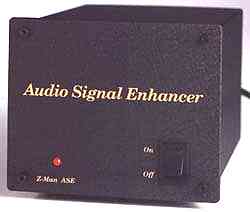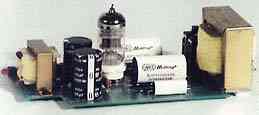Product Review - Z-Man Audio Signal Enhancer
- December, 1997
By Stacey L. Spears
![]()
 |
Z-Man Audio Signal Enhancer $198.00 Z-Man Corporation 2118 Batchawana SE Grand Rapids, MI 49508 Phone (800) 478-9727 or (616) 246-7929. |
Introduction
Christmas is only a few weeks away, so have you found that gift for your favorite audiophile? I think Z-Man Corporation might just have the perfect gift. I spent the last several weeks using the Z-Man Audio Signal Enhancer (ASE), a product that could make a pretty good stocking stuffer. The ASE is what you might call a black box. It is designed to be inserted between your CD player and preamplifier. It has one pair of inputs and one pair of outputs, with only a power switch and light on the front.
The ASE was created to improve the sound of harsh digital sources. This includes Laserdisc, Mini-Disc (MD), DCC, DVD, and Digital Satellites. While many consumers believe that the sound of their CD player is terrific, the high-end community is longing for its replacement. There is talk of 24 bit 96 kHz audio, but it is NOT here today and will not be here tomorrow. What can we do in the meantime to get the most enjoyment out of what we already have? You can go out and buy a new DAC or even one of those fancy little jitter boxes, but you are talking about a pricey cost to improve the sound. And what you spend on the extra boxes does not guarantee you will hear any improvements.
A look inside
So, the $198 question is what's inside the black box? And of course you might ask yourself why we need another component in the signal path. We always assume that the best possible sound comes from the purist signal, which translates to the shortest distance between the CD and your ears. But if this were the case in the absolute sense, we would all be using receivers, integrated amplifiers, or even the ubiquitous "boom box." On the other hand, we know that separates provide isolation between components for better sound overall.
| Back to the black box, inside is a slew of top-notch parts. At the heart of the ASE is the Sovtek 12AX7WXT+ electron tube. That’s right, a tube! Along with the Sovtek tube, you get MIT multicap capacitors, Holco precision metal film resistors, and gold plated connectors to boot. |  |
Who is the ASE for?
Well, the digital sources that benefit the most from the ASE often do not have digital outputs and, so, cannot benefit from an external DAC.These are the $139 CD players, and some of the older laserdisc players. The ASE will not only benefit the lower cost products, but even some of the higher quality products as well. Even some external DACs benefit from the ASE.
I first used the ASE with my Sony DSS receiver. I think DSS is one of the cooler products of 90s. High quality video, high quality sound, pay-per-view, etc. You can get network channels up to three hours earlier or later, that means X-Files at 6 PM on Sundays here on the West Coast! And you also get several music channels, which I consider the real gem of DSS. But these music channels are diamonds in the rough that often sound harsh and fatiguing. This could be blamed on the compression used to deliver the media or even the lower quality DACs found in DSS receivers. Only the Sony high-end model DSS receivers have digital outputs, so most people are using the analog outputs. The ASE really brings new life to these channels. Gone is the harshness normally associated with digital sources. The bass is more defined, and you can listen for hours without getting the desire to turn down the volume or even just shutting it off. With the ASE in place, the music channels on my DSS sounded a lot more like good CDs.
Another good application for the ASE is with the Sony Mini-Disc (MD) players, as these have to be the worst digital sources on the current market. The convenience is there, but the sound is not! My office partner here at Microsoft has an MD player. He loves to play music all the time, but after listening to it for just a few minutes, I get fatigued (auditory-wise), like someone is grinding a screwdriver in my ear. It's funny, but the things that first sold me on CD are the things I now try most to eradicate. When he lowers the volume, it's like the pressure is lifted from my ears. After I inserted the ASE between the MD and his powered speakers . . . ahhhhhhh . . . music at last. I am not saying that everything wrong with MD was cured, but I could listen to it now with getting listening fatigue. In fact, I never knew MD was capable of a higher enjoyment level. At first, he loved his MD player - after all, he listens to the music, not the technology. But oh, after I removed the ASE from his system, things have not been the same since. He's not happy anymore. Hey, Santa is coming soon. :-)
I then put the ASE into my own PC and satellite/subwoofer system. My PC gets more use than my home system during ship mode (getting ready for the final software version to be shipped) here at work. During those burrito-at-2-AM sessions, I listen to music 8 - 12 hours at a time, and low quality digital is not acceptable. The ASE has been a lifesaver. Music flows from the speakers to my ears, with real life to it. I have some generic equipment, a multi-spin CD-ROM drive, Sound Blaster 16, and a pair of Altec Lansing speakers. This is a good example of what a typical PC audio system is like. Connecting the ASE to a PC was much more difficult than I imagined because the audio output on the sound card and the audio input on the speaker system both have those little phono plugs. For this I used a couple of phono-to-RCA cables from Radio Shack. Well, they worked. Although I might have been able to get higher sound quality with better cables, I was not disappointed with what I achieved.
I also spent a lot of time with the ASE at home, and I tested it in a couple of different setups. This included my CLD-97 LD player, the Sony DVP-S7000 DVD player, and I even gave it a shot with the new Meridian 508.24 CD player. I also tried it with the outputs from my surround processor. Since I only had one ASE, this covered my left and right main channels. I bet that inserting a couple more ASEs into the system to cover the center and the two surround channels would be a killer idea. After all, some of the lower cost surround sound receivers could use some taming.
So how did it sound with the LD player? The DACs in the CLD-97 were very good when they were introduced. Pioneer used their Legato Link technology with the 97. But it was still a little cold, and by that I mean there was this slight edgy sound attached to everything. The ASE removed the edginess, there was a greater sense of presence overall, and instruments took on a more life-like sound.
DVD players have had some negative press on their CD sound quality. I don’t use my DVD player for CD music listening, but a lot of consumers who bought DVD players have dumped their CD players because they want the one-box solution for all discs. I can understand, because sometimes convenience is more important than other factors, but I am one who will always forgo convenience for quality any day. And, the bad press is valid. DVD players do sound a lot like low quality CD players, with perhaps the main reason being that the laser beam is designed primarily to track the DVDs, and just does double-duty when playing CDs. Adding the ASE to the chain GREATLY improved the musical aspect of my DVD player. It brought back the smoothness that high quality CD players are able to give.
Now, the results that I got when plugging the Meridian 508.24 into the ASE were different. It actually dulled the sound, and I did not like it. The sparkle that the Meridian has was removed, and the pristine sound was actually smeared.
I mentioned earlier about inserting the ASE in-between surround processors and the amplifier. This effect varied from component to component. I found the improvement worked best on some of the entry level Dolby Digital receivers out there. For example, I inserted it with the Pioneer Elite DD decoder and really was amazed at how good the 1812 Overture sounded on the Delos DVD Spectacular disc. The Delos disc is one of the best multichannel recordings around, but its fault is a slight edginess with DD. Well, it sounded much, much better with the ASE in place.
Associated Equipment
Z-Man is one of the few companies that actually recommend certain types of cables with their equipment to get you started. They suggest a 0.5 meter going from your CD player to the ASE and not greater than 1 meter from the ASE to your preamp/receiver. They also suggest using the Kimber PBJ cable for starters. Unfortunately, I did not have any Kimber or 0.5 meter cables to try. All of my interconnects range from 1 to 2 meters in length. When wiring the ASE, I stuck with all 1 meter cables. I used the Blue Angel from Nordost Flatline, the Monster M1500s and Sigmas, and some inexpensive Radio Shack Phono-to-RCA cables. Other equipment included the Sunfire Cinema Grand amplifier and Krell KAV-500 amplifier. I also used an entry level Adcom preamp, as well as Meridian and Pioneer Elite Surround Processors. Source components inlcuded the Sony Mini-Disc and DVD player, Pioneer CLD-97 LD player, Meridian 508.24 CD player, and some PC CD-ROM drives.
Conclusion
What have I learned from this? The ASE, while working its magic, does not affect all digital products the same way. The ASE may actually deteriorate the sound of a CD player that is already fine-tuned. How do you know if your CD player can benefit from the ASE? Take the following quiz. Are you happy with the sound of your CD player? Do you get tired after listening to the sound of your player for extended periods of time? If your answers were "no" and "yes" respectively, then the ASE is something you should consider inserting in your system. The ASE has a 30 day money-back guarantee, so it's worth a shot.
Stacey Spears
Manufacturer Response:
Thank you for not only doing a review of the ASE, but the positive comments you made,
and the trouble you went to to test the unit with various
digital sources. Your closing paragraph is exactly what I tell customers. If you have a
system that has a nice full and balanced sound, you don't need the ASE. And as you pointed
out, it can work against an already correct sounding system. But if you do have a system
that is excessively bright, edgy, and cold sounding, you want to try the ASE.
Again, thank you for the review.
Sincerely,
Gerald
![]()
� Copyright 1997 Secrets of Home Theater & High Fidelity
Return to Table of Contents for this Issue.

